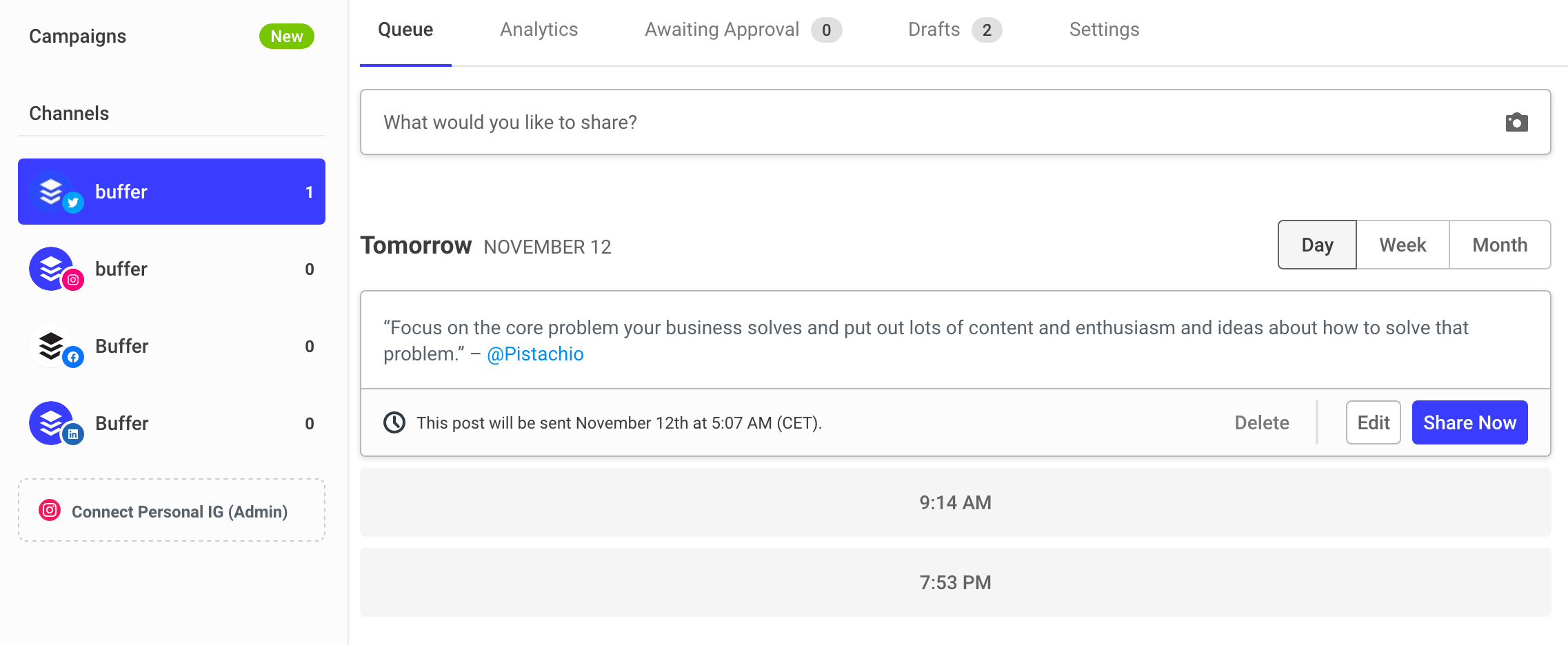
Social Media for Small Business: A Guide for 2025 and Beyond
Social media will play an increasingly crucial role in supporting small business growth. Here’s how (and why) you should work social media into your plans for 2025 and beyond.
Former Head of Content at Buffer
Summary
Social media will play an increasingly crucial role in supporting small business growth. Here’s how (and why) you should work social media into your plans for 2025 and beyond.
You will learn
- Why social media matters for small businesses
- The positive impact a small, loyal following can have
- How to measure the metrics that matter
Around the world, 47% of internet users ages 16 to 64 have spent more time on social media in 2020 than they did in 2019. And those users aren’t just mindlessly scrolling: ecommerce sales are on the rise as well. This only further highlights the value of social media for small business.
“In a sense, social media is our business,” says Laura Moss, cofounder of outdoorsy cat-lover company Adventure Cats, “It's where we engage with our audience, promote products, and even answer a lot of customer questions.”
In the coming years, social media will play an increasingly crucial role in driving sales, providing customer service, and improving brand awareness. Here’s how (and why) you should work this valuable asset into your plans for 2021 and beyond.
How social media helps small business
You’ve known for a while that social media for small business is important — but 2020 has made it essential. Seventy percent of small-business owners are concerned about financial hardships due to the COVID-19 crisis. At a time when money is tighter than ever, social media can be a lifeline.
While social media can serve many functions, here’s a quick look at some high-impact benefits of social media for small business:
- Low-cost brand recognition with free social media accounts or small-budget brand-awareness initiatives
- Targeted reach through tools, such as Instagram Ads or Facebook Ads, that homes in on specific demographics (i.e., age, gender, salary, location, etc.)
- Event promotion through features such as Facebook Events and Facebook Groups
- Customer service options that endears you to customers
5 Social media tips for small business
People typically choose a small business over a big-name company because they value the personalized experience and unique character of the business itself. You can use social media to show off your personality and get to know your customers better while also growing your business.
1. Determine which metrics matter
Before you start running reports, decide which metrics matter to you and your business. Don’t get caught up on “vanity metrics” — metrics that make you feel good but don’t help you make decisions, take action, or judge value. While it’s tempting to obsess over followers and likes, those metrics don’t necessarily serve your business goals. For instance, local businesses get more out of a small, local following than a large following that includes people who will never visit the businesses’ physical stores.
Don’t get caught up on “vanity metrics” — metrics that make you feel good but don’t help you make decisions, take action, or judge value.
Danni Eickenhorst, co-owner of St. Louis-based restaurant Steve’s Hot Dogs, has gained an impressive following on the restaurant’s social accounts. But when it comes to driving sales, local love is crucial. When Eickenhorst needed to get the word out about a restaurant event, she focused not just on the city but, more specifically, on the restaurant’s surrounding neighborhoods as well.
“We reached out to the neighborhood associations nearby and asked them to push out the word to their people,” Eickenhorst says. “They all pushed in their Facebook Groups and Nextdoor posts, and that was a huge help.”
The Facebook event reached 28,100 people and earned them 150 new Facebook page likes and 75 new Instagram followers. Thanks to the extra social media push, sales were three times as high as a typical Saturday. Plus, social media fans immediately requested similar events, leading to a second Six Feet ApartY, with additional events and local partnerships.

Social media tends to be among the first things on the chopping block for small businesses, because social media managers struggle to convince the company of its value. That’s why focusing on the right metrics is so crucial. Bosses might not be impressed by how many likes your post gets — but they’ll certainly be interested in how many sales it brings in.
“Social media is our second-biggest driver of sales,” Moss says. “Most customers say they discover us on Instagram and didn't realize we had a content site or a store until we promoted them on social.”
Of course, sales numbers aren’t the only valuable metric. You might also monitor the traffic social media drives to your website, engagement rates for individual posts, or even specific types of engagement, such as retweets versus likes. Every metric can give you information, and the value depends on whether or not that information helps you make decisions for your business.
2. Use reports to analyze what’s working (and what isn’t)
Once you decide on your key metrics, make sure you track them regularly by building custom reports that highlight what matters most to you. Remember: focus on data that drives business decisions, such as metrics that tell whether Instagram Shop Grid or Instagram Shop Post content drives more sales.

With reports, you can compare metrics such as engagement rates, click-throughs, and follower demographics to determine which type of content resonates with your audience. For instance, HIKI, a company with a line of products to minimize sweat, confirmed that their followers are mostly millennials and Gen Zers, so they craft content that speaks to that age group.
HIKI jumped on the “Put a finger down” trend on TikTok and got real about sweat problems — a tactic that would probably fall flat with baby boomers but got a lot of engagement from HIKI fans.
3. Own your personality
On social media, your followers come for your products and services — they stay because they like your style. Think of your social media as an extension of your brand’s voice, tone, and personality.
As you craft your brand persona, consider questions such as:
- What’s your tone? (Funny, playful, serious, informative, etc.)
- What are your top interests outside of your business?
- What are your values?
- Who are your friends? (Other brands or people you support, neighborhood businesses, etc...)
Make your brand’s persona part of your branding guidelines, and let your unique personality shine in your posts.
Tim Urch, social media manager at Huel, a company that delivers nutritionally complete food, crafted a persona that appeals to their customers on multiple levels. “Creating a sweet spot between what we want to say and what our audience wants to hear is tough” Urch says. “When those two things are the same, we’ve struck gold.”

Adventure Cats shows off their playful personality with cat puns and promotes their values by sharing the organizations they donate to — along with displaying a healthy dose of cute kittens, of course.

4. Use social media to provide great customer service
Customer service plays a major role in brand loyalty, and the majority of people ages 18-54 see social media as an effective channel for customer service. Here’s the bottom line: most of your customers expect support via social media and are almost equally likely to praise or complain about your response, so you might as well make it a great interaction.
Our complete guide to using social media for customer service can show you how to leverage social platforms effectively. But here’s the TL;DR: Superior customer service via social media boils down to three things: speed, tone, and results. People want quick responses from empathetic humans who are prepared to resolve problems.
5. Schedule a baseline of posts
Social media for small business is often something that gets regulated to the “whenever I have the time” category. But inconsistent activity isn’t a good look for any brand.
The good news is, just because social media is on 24/7 doesn’t mean you have to be. You can schedule posts ahead of time to ensure that your brand has a consistent presence. First, you’ll need to determine how often you want to post on each platform. Once you have your baseline, you can use Buffer's publishing tools to set posts for weeks in advance so your brand never appears to go dark on any social platforms.

Scheduling also gives you more visibility into your messaging over time. When you can look at all of your posts across platforms for the coming weeks, it’s easier to ensure that you’re varying your content. Plus, when you plan ahead, you have more time to pop in on different platforms for real-time engagement.
Authentic social media for small business is essential
By now, you know that having a social media presence is important, but you have to go beyond just showing up. Social media for small businesses thrives on authenticity and consistency.
“Social media is a totally invaluable channel for us,” Eickenhorst says. “Before I joined the company, Steve let the creativity part of social media slide. It wasn’t authentic, and business fell away.”
People want to see a genuine personality on social media, particularly from small businesses. If you’re simply going through the motions with generic posts and occasional product features, your customers won’t have a reason to stick around and engage with you. Authenticity is about owning the tone and style your fans have come to expect from you and using social media to listen to and engage with your audience.
“Now, we put real effort into varying our content and keeping it authentic,” Eickenhorst says. “Now, our audience [and business] is back.”
Try Buffer for free
180,000+ creators, small businesses, and marketers use Buffer to grow their audiences every month.
Related Articles

Finding trending songs on Instagram doesn’t have to be a guessing game. Use these tips to stay in the loop and boost your reach.

I’ve put dozens of AI writing tools to the test — here's a deep dive into my favorite AI writing generators and who I think they’ll be most useful for.

From subscriptions to UGC to merch — discover 13 ways to monetize your Instagram following, even if you don’t have a large following.